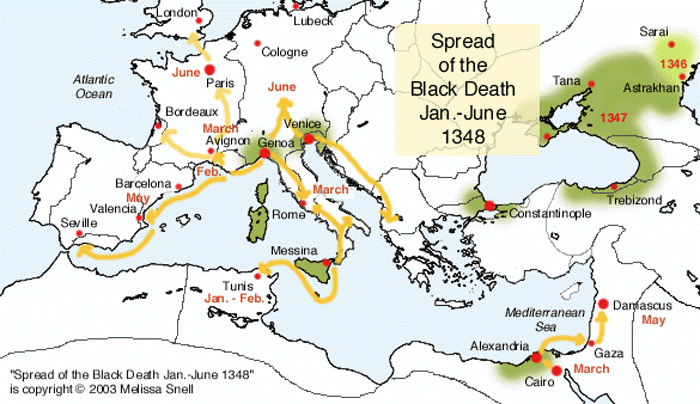THE MARCH OF THE PLAGUE
There are several theories to explain the start of Plague, but they all agree that a major source was China, Mongolia, and Hunan province, in particular. The nomadic tribesmen that populated the region seemed to know instinctively that something was wrong. A series of customs existed to avoid the disease.Trapping marmots, a host for the flea Xenopsylla cheopsis, was taboo; marmots could be shot at a distance only; slow-moving animals were avoided; furs of certain rodents could not be used.
Around 1330 Plague affected the local residents of the east cities and people following the trade routes, established in the previous two centuries. By 1345, it was in the lower Volga; by 1346 Astrakhan, the Caucasus, and Azerbaijan; by 1346 Constantinople and the Byzantine Empire; late autumn 1347 Alexandria, Egypt and southward along the Nile; India.
During the summer of 1347 Genoese merchants and their families were living in the city of Kaffa on the Black Sea, in the Crimea, when Tartars subjected it to a siege. During the prolonged siege an outbreak of disease affected the Tartar forces. The Tartar army catapulted corpses of the disease victims into the city. The merchants abandoned the city in vessels and set sail for Italy.
In October 1347 the Genoese arrived at the port of Messina, Sicily and the crews were dying of some unknown disease. City officials sealed the vessels for two days-but, of course, this had little effect on the rats, and their accompanying fleas, which descended and then went to the port.
In two months nearly half of the population of Messina was dead. The disease soon spread through the ports of Italy and reached the cities by early spring.
Another Genoese merchant ship carrying the disease to Marseille came in January 1348. Then Barcelona and Valencia were infected in few weeks.By that summer, the Plague reached Paris. It then spread east to Germany and north to England, reaching London in December 1348. During this time the Plague was known by the names of the Great Dying in England, das Grosse Sterben in Germany, and Magna Mortalis in Latin.
